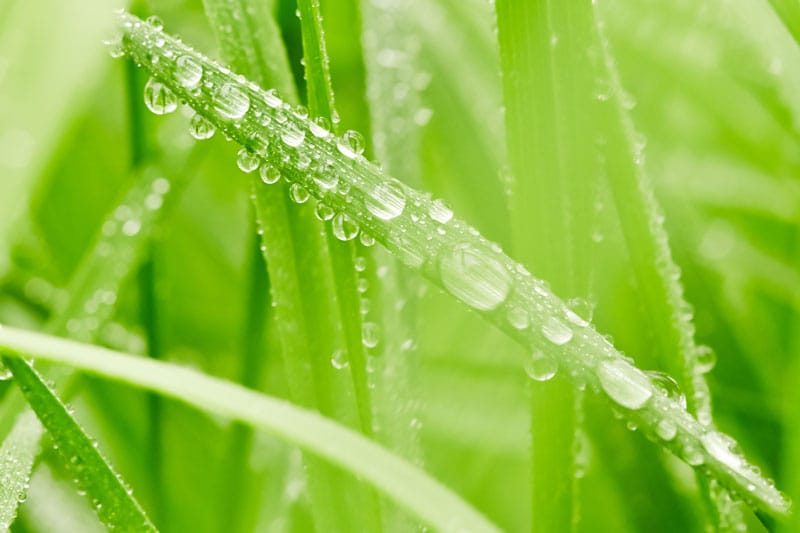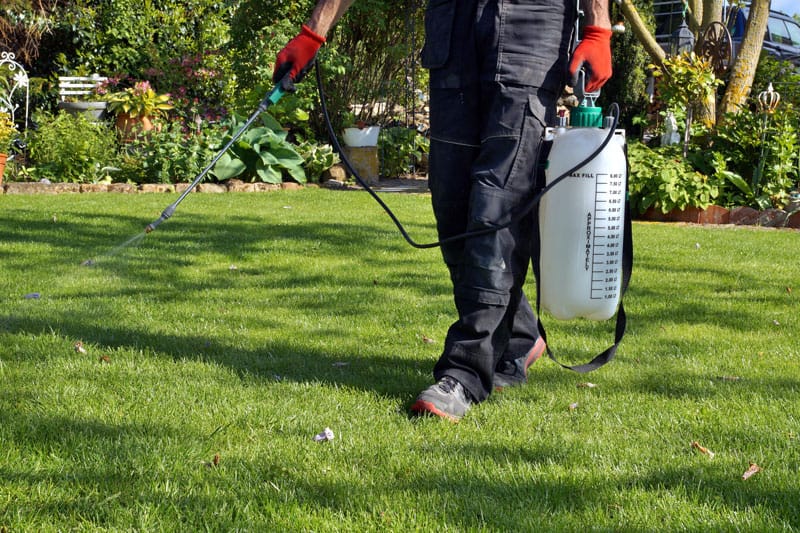Wetters can improve the effectiveness of your lawn care treatments. But what are they and how do they work?
Wetters – they’re a really useful tool for anyone who uses a sprayer to apply lawn treatments. Added to the sprayer tank they help foliar feeds to be absorbed better and can make herbicides work harder.
Farmers use wetters to help reduce the amount of chemical they are using. This keeps costs down (there’s no denying that farmers DO like to keep costs down!). And is potentially kinder to the soil and the environment by reducing the amount of synthetic substances we’re using in food production.
In lawn care, as in farming, all of the chemicals that are commercially available have been rigorously tested for safety. But that doesn’t mean it’s good practice to apply them willy-nilly. Quite often, less is more. Only use lawn care chemicals if there is no practical alternative and ALWAYS follow the manufacturers instructions to the letter. Even when it comes to using wetters with them.
What is a wetter?
Have you ever waxed your car and noticed that afterwards, the raindrops just sit on the surface? That’s the result of two things. First of all, surface tension in the water creates lovely spherical drops. Secondly, the waxy surface is too smooth to burst the water droplets.

Surface tension means that droplets of water stick to grass blades – particularly with species like ryegrass where one side of the grass blade has a waxy coating.
Depending on the species, many plant leaves have a waxy coating on them too. So, when droplets of water land on them, they will either sit there until they evaporate, or they’ll slide off onto the soil. It’s nature’s way of making sure that water gets to the roots, where it’s needed. BUT, when that droplet of water contains something that you want the leaf to absorb it’s not helpful if that lands on the ground.
Wetters and surface adjuvants are substances that change the relationship between the water droplet and the surface it lands on. They allow the active ingredients to come into contact with its target.
Wetters work by reducing surface tension so that the droplet bursts instead of sitting on the surface. A bit like dropping a water balloon, only on a much smaller scale. In short – they make water wetter.
Surface adjuvants, soften the waxy coating of the leaf so that spray can more easily be absorbed.
When to use wetters for lawn care
Whether or not you use a wetter to enhance your lawn care is entirely up to you. Personally, I get on fine without them when it comes to seaweed treatments, Humic acid, iron treatments and the like. I’m happy with the results I’m getting and I don’t mind if those active ingredients get into the soil. However, I might consider using wetters if I were applying glyphosate to kill off an ugly lawn, or if I needed to use a selective herbicide to deal with a heavy infestation of weeds. (Especially if there’s bad weather forecasted and I need those chemicals to be absorbed before the rain washes them off)
Some people apply a wetting agent to the soil. The theory is that theyhelp the soil to absorb water better and the lawn stays greener for longer in summer. For most lawns, I would say this is totally unnecessary. Particularly if you are up to date with your scarification and aeration. If you have a thick layer of thatch in your lawn, no amount of wetter will help the situation.
The exception to that rule is when the lawn develops a condition called dry patch. Dry patch sometimes occurs on golf greens and is caused by hydrophobic soil. In other words, the soil will actively repel water. That means that the grass becomes dehydrated and discoloured – it may even die. Researchers are still trying to figure out what causes dry patch. However, greenkeepers know that the way to relieve the problem is a combination of spiking, slitting and applying wetting agents.
.

The in’s and out’s of using wetters
The thing about using wetters with sprays, is you have to get the balance exactly right. Too little, and they won’t do their job. Too much, and the surface tension becomes so low that either your spray runs straight off the leaf, or it evaporates too quickly. For plants to absorb anything – be it nutrients through the roots or herbicide through the leaf, the active component needs to be dissolved in water. If that water has evaporated – the chemicals will just sit on top of the leaf.
You also have to be sure you’re using the right wetter for the lawn treatment you’re applying. These are chemicals and the last thing you need is an unwanted chemical reaction in your sprayer resulting in some strange substance that does goodness knows what to your lawn and your equipment. I once heard of a groundsman who made an error with the mix and ended up with 3,000 litres of blue gunk trapped inside his sprayer……that was a costly mistake!
So wetters definitely have a place in lawn care – but they need to be used wisely and always follow the instructions to the letter.
Related articles
Using organic seaweed treatments to give your lawn the wow factor
Redthread and other summer lawn disorders.
Common lawn weeds and how to treat them.
